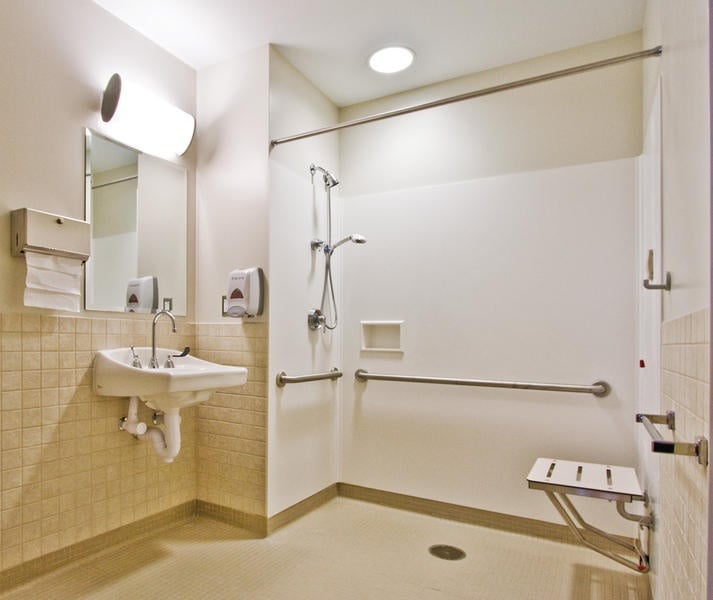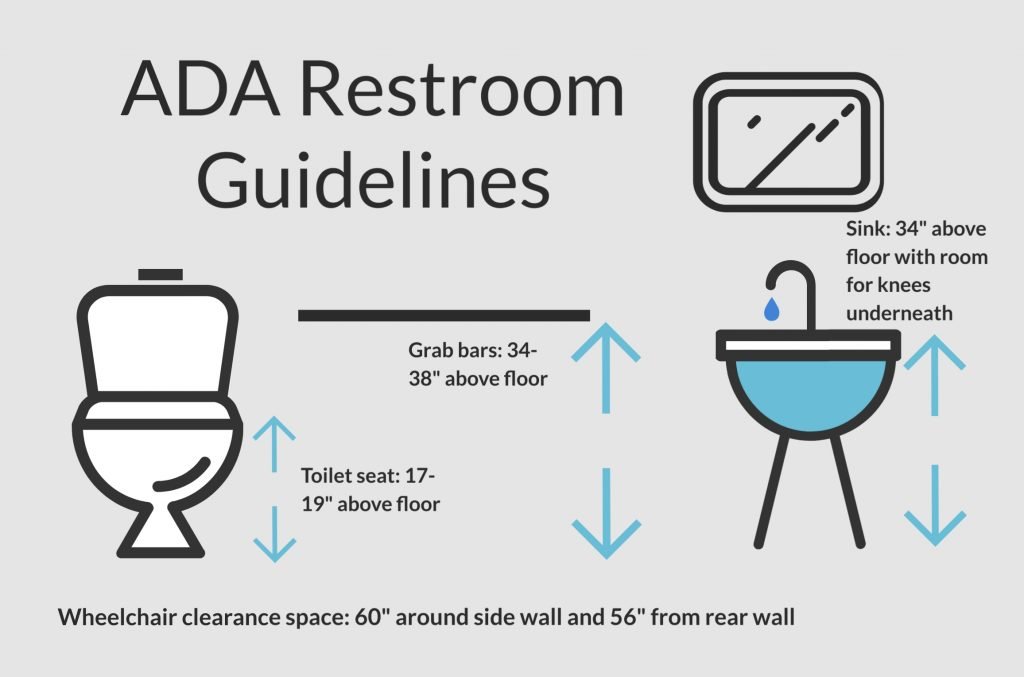ADA Bathroom Design Principles: Ada Compliant Bathroom With Shower

The Americans with Disabilities Act (ADA) establishes guidelines for accessible design, ensuring that individuals with disabilities have equal access to public spaces, including bathrooms. These principles are crucial for creating inclusive environments that promote independence, safety, and dignity for all.
Ada compliant bathroom with shower – ADA-compliant bathroom design goes beyond mere compliance; it’s about creating spaces that are usable, comfortable, and safe for everyone. By incorporating these principles, designers and architects can ensure that individuals with disabilities can navigate and use bathroom facilities with ease and confidence.
An ADA compliant bathroom with shower, while prioritizing accessibility, doesn’t have to be devoid of style. The recent trend of partially open bathrooms in Best Western hotels demonstrates how openness and functionality can coexist. These design elements can be incorporated into an ADA compliant bathroom, creating a space that is both welcoming and accessible.
Accessibility and Usability, Ada compliant bathroom with shower
Accessibility and usability are paramount in ADA-compliant bathroom design. This involves creating spaces that are easy to navigate and use, regardless of an individual’s physical abilities.
An ADA compliant bathroom with shower must prioritize accessibility, but comfort is equally important. Choosing the right geyser can significantly impact the overall experience, and considering factors like water pressure and energy efficiency is crucial. To make the best decision for your specific needs, explore which geyser is best for bathroom and ensure a comfortable and safe showering experience in your ADA compliant bathroom.
- Clear and unobstructed pathways: Wide doorways, hallways, and turning radii provide ample space for wheelchairs, walkers, and other mobility aids. This ensures safe and comfortable movement throughout the bathroom.
- Accessible fixtures: ADA standards dictate the height, reach, and operability of fixtures like toilets, sinks, and showers. For example, grab bars, raised toilet seats, and lever-style faucets are designed for ease of use.
- Accessible controls: All controls, such as faucets, shower controls, and toilet flushers, must be operable with one hand and without excessive force. This ensures that individuals with limited dexterity can use the facilities independently.
Safety and Independence
Safety and independence are essential components of ADA-compliant bathroom design.
- Non-slip surfaces: Floors and shower surfaces must have slip-resistant materials to prevent falls, particularly for individuals with mobility impairments. This can include textured tiles or non-slip coatings.
- Grab bars: Strategically placed grab bars provide support for individuals who need assistance with balance or transferring. Grab bars should be installed near toilets, showers, and bathtubs, ensuring stability and reducing the risk of falls.
- Adequate lighting: Well-lit bathrooms improve visibility, reducing the risk of accidents and enhancing safety. This is especially important for individuals with visual impairments.
Shower Accessibility Features

Creating an ADA-compliant shower involves adhering to specific design requirements that ensure ease of use and accessibility for individuals with disabilities. These requirements cover various aspects, including minimum dimensions, grab bar placement, and shower seat options.
Shower Dimensions and Grab Bar Placement
The ADA Standards for Accessible Design provide guidelines for shower dimensions and grab bar placement to ensure safe and comfortable use.
- Minimum Shower Area: The minimum clear floor space within the shower area is 30 inches by 30 inches (76 cm by 76 cm). This space allows for maneuvering and turning within the shower.
- Grab Bar Placement: Grab bars are essential for stability and support. The ADA requires at least one grab bar to be installed within the shower area.
- Location: The grab bar should be positioned within reach of a seated individual, typically 33 inches to 36 inches (84 cm to 91 cm) above the shower floor.
- Type: The grab bar must be securely mounted and capable of supporting at least 250 pounds (113 kg).
- Shower Seat: An integrated or removable shower seat is highly recommended to provide a safe and comfortable seating option for individuals with mobility limitations. The seat should be positioned within reach of the grab bar and have a minimum width of 18 inches (46 cm) and a depth of 15 inches (38 cm).
Shower Seats for Accessibility
Shower seats play a crucial role in enhancing shower accessibility for individuals with mobility limitations. Different types of shower seats cater to varying needs and preferences.
- Integrated Shower Seats: These seats are permanently built into the shower structure. They offer stability and are often preferred for their seamless integration with the shower design.
- Removable Shower Seats: These seats can be easily removed and stored when not in use. They provide flexibility and are ideal for users who may not require a seat for every shower.
- Folding Shower Seats: These seats fold away when not in use, maximizing space in the shower. They are a practical option for users who need a seat occasionally.
- Adjustable Shower Seats: These seats can be adjusted in height to accommodate users of different heights. They offer versatility and ensure a comfortable seating position for all users.
Showerheads for ADA-Compliant Bathrooms
Selecting the right showerhead is essential for ensuring comfort and accessibility in an ADA-compliant bathroom.
| Type of Showerhead | Features | Suitability for ADA-Compliant Bathrooms |
|---|---|---|
| Handheld Showerhead | Adjustable spray patterns, easy to maneuver, can be used for both showering and rinsing | Highly suitable, provides flexibility and ease of use for individuals with limited mobility |
| Rainfall Showerhead | Provides a wide, gentle spray, creates a spa-like experience | Suitable for individuals with no mobility limitations, may be challenging for users with limited reach or dexterity |
| Combination Showerhead | Offers multiple spray patterns, including handheld and overhead options | Versatile and adaptable, can be customized to meet the needs of different users |
| Water-Saving Showerhead | Reduces water consumption without compromising water pressure | Eco-friendly and cost-effective, can be incorporated into ADA-compliant designs |
ADA Compliant Bathroom Fixtures and Equipment

Creating an ADA compliant bathroom involves selecting fixtures and equipment that are designed to be accessible and usable by individuals with disabilities. This includes ensuring that all elements are positioned at appropriate heights, have clear lines of sight, and can be easily operated.
Toilets
ADA-compliant toilets must meet specific requirements to ensure accessibility and ease of use. These requirements include:
- Height: The toilet seat must be 17-19 inches high from the floor, allowing for comfortable use by individuals with mobility limitations.
- Clearance: A minimum of 30 inches of clear floor space is required in front of the toilet to allow for wheelchair access and maneuverability.
- Grab Bars: Two grab bars, one on each side of the toilet, are essential for stability and support. These bars should be positioned at a height that is comfortable for individuals of different heights and should be made of durable materials.
Sinks
ADA-compliant sinks must be designed to provide accessibility and ease of use for individuals with disabilities. This includes:
- Height: The sink should be positioned at a height that is comfortable for individuals in wheelchairs, typically 29-34 inches from the floor.
- Depth: The sink bowl should be deep enough to accommodate individuals with limited reach.
- Clearance: There should be adequate space under the sink to allow for wheelchair access and maneuverability.
- Faucets: ADA-compliant faucets must be lever-style, allowing for easy operation with one hand.
Lever-Style Handles
Lever-style handles are a crucial element of ADA-compliant bathroom fixtures. They are designed to be easier to operate than traditional knob handles, particularly for individuals with limited hand dexterity or arthritis. Lever handles require less force to turn and can be activated with a simple push or pull motion.
Mirrors and Storage Solutions
ADA-compliant bathroom mirrors and storage solutions should be designed to provide accessibility and ease of use.
- Mirrors: Mirrors should be positioned at a height that is comfortable for individuals in wheelchairs, typically 36-40 inches from the floor. This allows for clear visibility and promotes independence.
- Storage Solutions: Storage solutions should be accessible and easy to use. This includes:
- Open Shelves: Open shelves allow for easy access to items and are ideal for individuals with limited reach.
- Pull-Out Drawers: Pull-out drawers provide easy access to items that may be difficult to reach.
- Adjustable Shelves: Adjustable shelves allow for customization based on individual needs and preferences.
